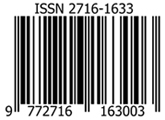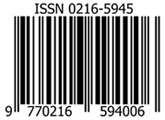AKSARA INCUNG DALAM NASKAH DI KERINCI (INCUNG SCRIPT AND MANUSCRIPT IN KERINCI)
Abstract
Incung script is the script used in Kerinci, the only local script that has ever developed in Central Sumatra. This script is used in the tradition of textbooks in Kerinci, which has produced nearly 134 manuscripts with different contents, in the search for researchers generally contained Tembo or genealogy and mindu coral or lamentation and by using materials in the form of horns and bamboo. Therefore, in this further search the writer uses a descriptive analytical method and in this qualitative study is accompanied by a philological and codicological approach to assist in identifying the manuscripts and the ins and outs that accompany it and presenting the edition of the text, the meaning of the content and the context of the contents of the manuscript. The results of this study show that the incung script is very different from the script in the surrounding area (Bengkulu, Lampung and South Sumatra) both in terms of its shape and naming. Where the name of this script is written directly in the text of the text written as (h) incung not rencong as some researchers have previously thought. In the tradition of communication, it not only uses horns and bamboo, but also uses media in the form of daluwang and lontar, as well as contents, there are also rajahs and mantras and other important notes, such as notes of debt and or fines.
Full Text:
PDFReferences
Adelaar, K.A. 1992. Proto-Malayic: The Reconstruction of its Phonology and Parts of its Lexicon and Morphology. Canberra: A.N.U. Printing Service.
Alimin, et.al. 2003:” Sastra Incung Kerinci”. Kerinci: Dinas Pariwisata dan Kebudayaan Kabupaten Kerinci.
Baried, Siti Baroroh dkk,. 1985. Pengantar Teori Filologi. Jakarta: P3B.
Ernanda. 2011. On the loss of the phrasal alternation in Pondok Tinggi dialect of Kerinci: A Stochastic Optimality Theory Approach. Master thesis Faculty of Arts. Radboud University Nijmegen.
Harimurti. 1982. Kamus Linguistik. Jakarta: PT. Gramedia.
Hartati, Asri. 1994. Asal Usul Tulisan dan Pengembangannya. Jakarta: Emiltaska Triyasa.
Hermansyah. 2010. Ilmu Ghaib Di Kalimantan Barat. Jakarta: Gramedia.
Miller Christopher. 2011. Indonesian and Philippine Scripts and extensions not yet encoded or proposed for encoding in Unicode as of version 6.0.
Mulyadi, Sri Wulan Rujiati. 1994. Kodikologi Melayu Di Indonesia, Jakarta: Lembaga Sastra Universitas Indonesia.
Suliensyar, Hafiful Hadi. “Idu Tawa Lam Jampi: Mantra-mantra dalam Naskah Surat Incung” Makalah dalam Seminar Internasional Pernaskahan Nusantara, Surakarta 25-25 September 2017.
Surakhman, M. Ali. 2019. “Naskah Incung Sastra Melayu Klasik Yang Terlupakan”. Jurnal Siddhayatra: Jurnal Arkeologi. Vol. 24 (1) Mei.
Kozok, Uli. 2006, Kitab Undang-Undang Tanjung Tanah Naskah Melayu Yang Tertua, Jakarta: yanassa dan Yayasan Obor Indonesia.
. 2009. Surat Batak: Sejarah Perkembangan Tulisan Batak: Berikut Pedoman Menulis Aksara Batak dan cap Si Singamangaraja XII. Jakarta: Gramedia.
Voerhove. Tambo Kerinci: Salinan Tulisan Jawa Kuno, Incung dan Melayu Disimpan Sebagai Pusaka Di Kerinci. Leiden [t.p], 1969.
Westenenk, L.C. 1922. “Rèntjong-schrift”. Tijdschrift voor Taal-, Land- en Volkenkunde, vol. 61. Batavia: Albrecht en Co./’s-Gravenhage: M. Nijhoff.
ZE, Deki Syaputra. 2019. “Ritus dan Manuskrip (Korelasi Naskah dengan Kenduri Sko di Kerinci)”. Hadharah Jurnal Keislaman dan Peradaban. Vol. 13. No. 2 Desember.
Refbacks
- There are currently no refbacks.

This work is licensed under a
Creative Commons Attribution-NonCommercial-ShareAlike 4.0 International License.




